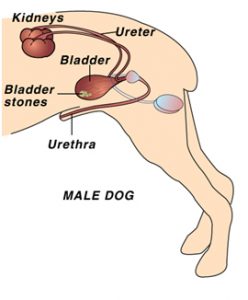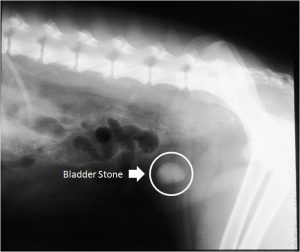Bladder And Kidney Stones
Stones cause lots of concerns for dog owners. We seem to be seeing an increased incidence over the last several years. I believe due to the widespread use of dried, processed kibble.
Dr. Donald Strombeck, DVM, PHD and professor emeritus, at the University of California, Davis School of Veterinary Medicine has over 50 years of clinical experience in small animal practice. He stated, ‘The quality of pet foods may be the most important factor in many common medical and surgical problems. Before 1950, when pet owners seldom fed their pets commercial pet foods (they fed them mostly owner-prepared foods), the incidence of gastrointestinal problems was much lower than it is now.’
Stones are painful, potentially dangerous and frustrating to treat.
What are they?
In dogs and in humans, the composition and development of stones are similar. They are usually made up of mineral salts that occur naturally in the body. Minerals like calcium, magnesium, ammonia, phosphorus and carbonates. These produce stones similar to the texture of limestone.
There are 2 major types of stones, sometimes called calculi or uroliths.
1. Struvite
2. Oxalate
Both of these have different causes, treatments and risk factors.
Let’s start with the most common form, struvite stones.
What causes Struvite Stones?
Bacterial infection is the culprit in this case.
Normal pH in the urine of healthy dogs is slightly acidic. With 7 being neutral, we would like to see a dog’s urine at between 5.5 to 6.5. Anything over 7 means the urine is alkaline. In an alkaline urine, minerals tend to clump together, they don’t dissolve like they do in an acidic environment.
Bacteria do 2 things.
1. When they decompose, they make the urine more alkaline.
2. They provide a target for stone formation. Minerals cling to these small debris-like particles and form stones.
Risk Factors
– 85% female dogs due to short urethra
– small breed females
– presence of urinary tract infection
– older dogs with decreased immune response who are more prone to bladder infections
– dehydration
– fewer opportunities during the day to go outside for potty breaks
Prevention and treatment
The number one factor is dehydration. Diets made up exclusively of processed foods like kibble are very dehydrating. They concentrate the urine and increase the likelihood of infection and stone formation.
Dr. Dennis Chow presented a paper at the 2004 Small Animal Proceeding Symposium of the American College of Veterinary Surgeons wrote, “Water may be the most important nutrient to prevent recurrence of stones. “
Water dilutes the urine creating less concentrated minerals.
Frequent urination also is extremely important. Please don’t allow your dog to go all day without a chance to pee!
Feeding a fresh whole food diet dilutes the urine. Most moist foods are at lease 70% water compared to kibble which is a mere 10%. Kibble also is high in refined carbohydrates which contribute to an alkaline urine creating the perfect environment for stone formation and infection.
Fresh ingredients and a better quality food help with overall immune system health and provide less stress on the kidney and bladder.
If your dog has a tendency towards bladder infections, I always suggest monitoring your dog’s urinary pH. It sounds complicated but all you need are human testing strips that can be purchased online. Since pH can vary throughout the day, test at the same time each day. I recommend first thing in the morning. Simply place the strip under the dog as she pees or you can collect it in a clean pie plate. Follow the instructions on the testing strip package and in no time, you’ll be a pro.
Checking pH is important if your dog is prone to urinary tract infections(UTI’s). You can see if the urine stays acidic or creeps up. That way you can have the urine tested for bacteria.
PH monitoring also helps to see how your dog reacts to her food when no infection is present. As long as the pH stays acidic there is no need to alter her diet.
Always have your dog treated for the underlying bacterial infection.
Oxalate Stones
What causes Oxalate stones?
Oxalate is a metabolic by- product produced in the body. About 50% is produced naturally and 20-50% comes from the diet.
These stones form more often in an acidic urine. Research still has not found a good explanation as to why. Some dogs are genetically predisposed to this stone formation and there are theories that have not been verified.
An interesting statistic is that in 1981 (according to the Minnesota Urolith Center) 78% of stones struvite and 5% were oxalate. As of 2006, 39% were struvite and 41% were oxalate.
Risk Factors
Generally, these occur in male dogs.
Risk factors include:
– dehydration the most important factor
– obesity
– sedentary lifestyle
– neutering
– drugs like antibiotics and prednisone
– diuretics
– Cushing’s Disease
– stress
My personal theory for an increase in oxalate stones is due to the increased use of anti-inflammatory drugs used to treat arthritis, allergies, inflammatory bowel disease and anything that itches.
Prevention and Treatment
Most dogs with oxalate stones due need to have surgery to remove them. There are other methods that need to be discussed with your veterinarian.
Prevention is another matter. There certainly is controversy around diet and oxalate stones but everyone agrees that water and a moist, whole food diet it best. No kibble!
Keeping the body hydrated and the urine dilute is the most important factor. Change the water in the bowel frequently. Consider a dog fountain. They love to drink out of the hose and this is the next best thing.
Do make sure your dog has frequent potty breaks.
It is a good idea to supplement with B complex vitamins, probiotics and potassium citrate(this can raise the urinary pH, making it more alkaline). As with struvite stones, it is wise to monitor urinary pH.
 Feed more frequent small meals.
Feed more frequent small meals.
Include meat, eggs and dairy in the diet while avoiding high oxalate content foods like spinach and sweet potatoes. Do keep in mind that boiling vegetables does lower the oxalate content so raw vegetables are naturally higher.
You know your dog best. If he appears lethargic, seems to want to pee more frequently with very little output, has accidents in the house or has blood in his urine, get him to the vet.
As with most things in life, it may be more difficult to feed a whole food diet but the results on your dog’s health are worth it. Help reduce the possibility of stone formation by keeping your dog hydrated. Feed a good quality nutritious food and avoid processed kibble as much as possible.
Yours in good health,
Dr Janice Elenbaas






